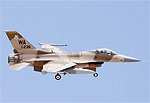Aggressors take off for joint, coalition training in Pacific
 EIELSON AIR FORCE BASE, Alaska -- Fourteen F-16 Fighting Falcons from the 18th Aggressor Squadron took off Jan. 17 in transit to Hickam Air Force Base, Hawaii, and Andersen Air Force Base, Guam.
EIELSON AIR FORCE BASE, Alaska -- Fourteen F-16 Fighting Falcons from the 18th Aggressor Squadron took off Jan. 17 in transit to Hickam Air Force Base, Hawaii, and Andersen Air Force Base, Guam.
The group of fighters, along with more than 150 maintainers from the 354th Maintenance Group, is deploying to support the CENTURY ALOHA and COPE NORTH exercises.
"It's been an enormous challenge to get all the resources from this base and the other locations all together to make this come together," said U.S. Air Force Capt. Jaime Samson, an 18th Aggressor Squadron air battle manager. "There have been so many moving parts along with working with career fields I'm not familiar with. After all is said and done these will be great training opportunities."
The exercises are meant to prepare U.S. Airmen, Sailors and Marines along with coalition partners in the Pacific theater of operations for contingency operations if the need arises.
"Having exercises are an integral part of staying ready for anything," Samson said. "We are the smallest Air Force we have ever been and keeping trained with our joint and coalition partners enables us to be ready to cover down for the entire Pacific region."
Maintainers will keep the jets in top running order throughout the one-month deployment.
Chief Mark Long, the 354th MXG quality assurance superintendent, said keeping up with the regular scheduled maintenance happens no matter where the jets are located, so transferring tools and equipment becomes a challenge.
"Mission accomplishment and the big-picture results of the job keep these Airmen motivated to overcome these challenges and get the tasks completed every day," he said. "Being able to be part of that brings a big sense of satisfaction."
Combined, the Aggressors will fly more than 400 sorties, exceeding 1,000 flight hours, training alongside aircraft from around the world including the F-22 Raptor, which has recently been employed for the first time in combat.
"When this is all done we have trained a lot of people to be combat ready," Samson said. "After all the challenges we've overcome to make this happen it's well worth it to have the pilots, maintainers, Pacific partners and entire bases with a lot more knowledge to stand ready when the need arises."